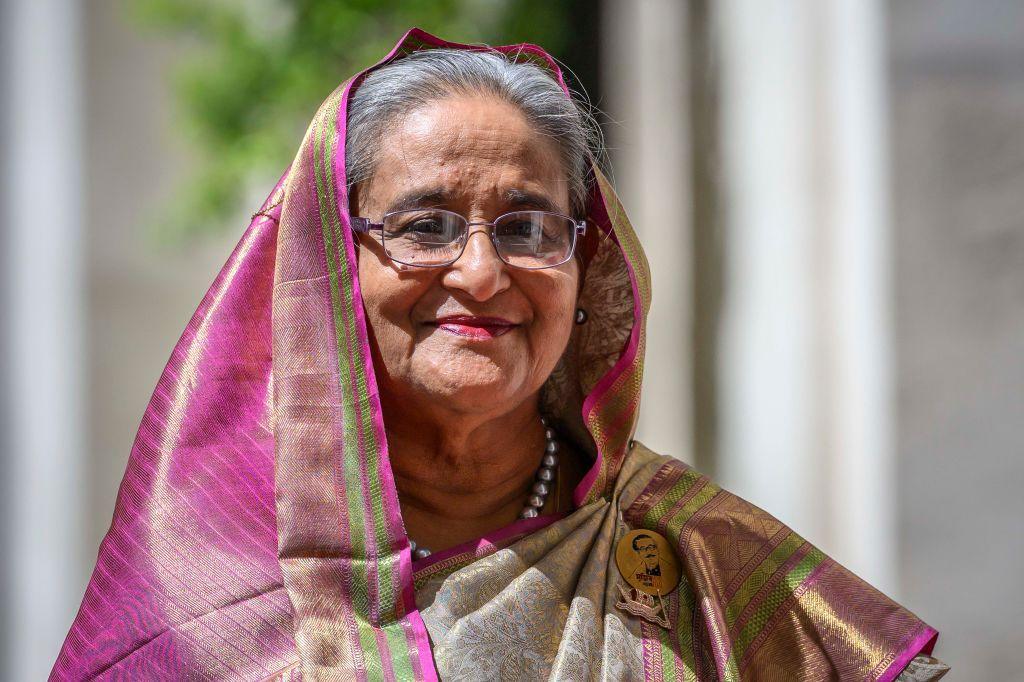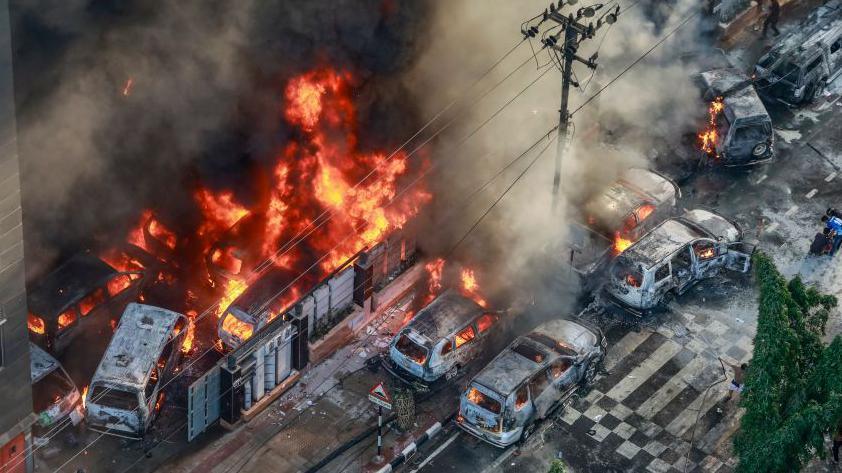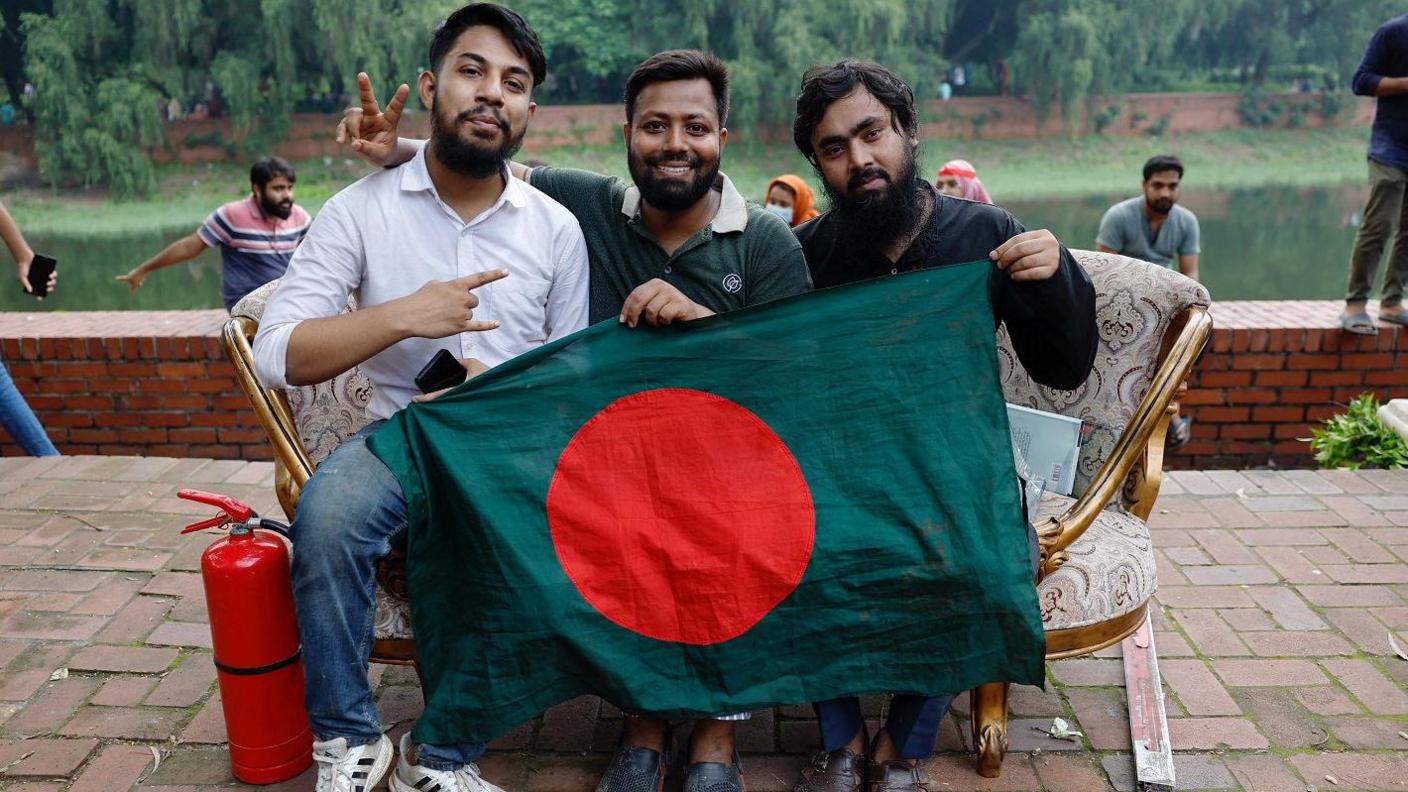What sparked the protests that toppled Bangladesh's PM?

Prime Minister Sheikh Hasina fled after her 15 year-rule ended abruptly
- Published
Bangladesh is at a historic turning point.
Weeks of anti-government protests have toppled its long-serving prime minister Sheikh Hasina, and an interim government is expected to be formed.
After Ms Hasina resigned and fled the country on Monday, huge crowds stormed her official residence in Dhaka amid reports of looting and disorder in the capital.
At least 20 people were killed in the violence, adding to the more than 90 deaths on Sunday – which already marked the worst single-day casualty figure from any demonstrations in Bangladesh’s recent history.
Now, Ms Hasina – a former pro-democracy icon, who critics say had become increasingly autocratic during her 15-year reign – is in India. It's not yet clear if she will stay there or head elsewhere.
How did the protests begin?
The protests began in early July as peaceful demands from university students to abolish quotas in civil service jobs - a third of these are reserved for relatives of veterans from Bangladesh’s war for independence from Pakistan in 1971.
The campaigners had argued the system was discriminatory and needed to be overhauled. Although their request was largely met, the protests soon transformed into a wider anti-government movement.
“It’s not [just] students anymore, it seems that people from all walks of life have joined the protest movement,” Dr Samina Luthfa, assistant professor of sociology in the University of Dhaka, told the BBC last month.
As the movement expanded, clashes followed, and over 300 people were killed in the unrest.
Bangladeshi media and protesters blamed police for the spiralling death toll. The government, though, maintained that officers only ever opened fire out of self-defence or to protect state property.
Ms Hasina repeatedly cut off internet access in parts of the country, imposed a nationwide curfew, and described those demonstrating against her as “terrorists” seeking to “destabilise the nation".
But the campaign of civil disobedience that had taken hold showed little signs of abating. And there were growing fears that a prolonged standoff could lead to more bloodshed.

Bangladeshi students set fire to the country's state broadcaster on Thursday
Why were students angry?
Discontent was brewing for a long time in Bangladesh, and the protests didn’t happen in a vacuum.
Though the South Asian nation - which is home to 170 million people - was one of the fastest growing economies in the world, experts pointed out that growth had not translated into jobs for university graduates.
Estimates suggested that around 18 million young Bangladeshis were looking for jobs and university graduates faced higher rates of unemployment than their less-educated peers.
Bangladesh had become a powerhouse of ready-to-wear clothing exports. The country sold around $40 billion worth of clothes to the global market. The sector employed more than four million people, many of them women. But factory jobs were not sufficient for the aspiring younger generation.
And that's partly why they wanted the quotas in government jobs to go - because that meant there would be more jobs for them.
Bangladesh issues high security alert as deadly protests escalate
- Published18 July 2024
Bangladesh students defy ban to continue protests
- Published19 July 2024
Why did the protests grow?
Even after the top courts scrapped the quotas, the protests continued, spreading beyond students, because the brutal crackdown unleashed more anger against Ms Hasina's government.
Her rule had transformed Bangladesh with new roads, bridges, factories and even a metro rail, but there were also allegations of rampant corruption.
Per capita income tripled in the last decade as more than 25 million people were lifted out of poverty over 20 years, accordng to the World Bank. But many felt that the growth was mostly helping those close to the PM's Awami League.
"We are witnessing so much corruption," Dr Luthfa said. “Especially among those close to the ruling party. Corruption has been continuing for a long time without being punished.”
Social media in Bangladesh in recent months was dominated by discussions about corruption allegations against some of Ms Hasina’s former top officials – including a former army chief, ex-police chief, senior tax officers and state recruitment officials.
The anti-corruption commission had began investigating former police chief Benazir Ahmed – once seen as a close ally of Ms Hasina – for amassing millions of dollars. He denied the allegations.
Even as Ms Hasina promised to tackle corruption, she admitted that she had sacked a household assistant for allegedly stealing $34 million of state funds.
Such shocking revelations didn’t escape ordinary Bangladeshis, who had been struggling with the escalating cost of living.
Rights activists pointed out that space for democratic activity too had shrunk on Ms Hasina’s watch - the government was accused of stifling dissent, silencing the media and government critics, and jailing or disappearing its strongest critics. But ministers denied the charges.
“The anger against the government and the ruling party have been accumulating for a long time,” Dr Luthfa said. “People are showing their anger now. People resort to protest if they don’t have any recourse left.”

Protesters pose with the Bangladesh flag while on a sofa looted from the PM's residence
What comes next?
It's too early to say what Bangladesh's immediate future holds.
Ms Hasina's long tenure, although contentious, also brought some stability and economic growth. So amid the hope, there is concern about the political vaccum her sudden resignation has created.
The release of jailed former PM Khaleda Zia was ordered, along with student protesters.
The main opposition - Ms Zia's Bangladesh Nationalist Party (BNP) - boycotted elections in 2014 and again in 2024, saying free and fair elections were not possible under Ms Hasina.
They wanted the polls to be held under a neutral caretaker administration. Ms Hasina had always rejected this demand but this is now a possibility.
Political parties and protest leaders began talks on Monday as international governments called for an orderly and democratic transition of power.
Bangladesh’s army chief Gen Waker-uz-Zaman – who announced the plan to form an interim government in the country – offered few details on what it could look like, or who might lead it.